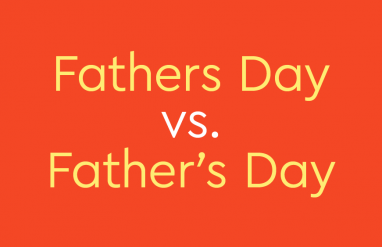The Persian grouchy little cat wanted food. Wait, that doesn’t sound right. How about The little Persian grouchy cat wanted food? No, something still sounds off. One more time. The grouchy little Persian cat wanted food. Ah, that’s it! Why is that?
Native and fluent speakers of English carry around in our heads a lot of invisible rules and guidelines about how English works, and one of them is the order in which we place adjectives. This is just one of many weird things that often make English an especially tricky language to learn.
What is the order of adjectives?
In writing and speech, we can put adjectives in two different places. Most of the time, we place adjectives directly before the nouns they modify, as in Blanca is a cute kitten. Adjectives can also come after a linking verb, as in Blanca is cute. In either case, things are pretty simple when we only use one adjective.
But what if we want to use more than one adjective to describe the same noun? Well, then, you need to buckle up because this grammatical ride is about to get bumpy. To a native English speaker, the sentence I bought seven yummy red apples sounds a lot better than I bought red yummy seven apples. Interestingly, a speaker is likely to say the first sentence without even considering what order the adjectives should be in. Adjective order comes naturally to many English speakers because to them a sentence just “sounds right” when adjectives are used in the “correct” order.
However, there is some method to the madness, and most grammar resources agree on a particular adjective order. Adjectives are usually grouped into special categories, and each category has its place in adjective order.
What are coordinate and cumulative adjectives?
Before we can actually get to adjective order, we first need to know about coordinate and cumulative adjectives. The reason for this has to do with the most dreaded of all punctuation marks: the comma. Wait, wait, come back! We can handle—gulp—comma usage if we work together.
When used before nouns, adjectives may or may not use a comma depending on if they are coordinate or cumulative adjectives. In general, two or more adjectives are considered to be coordinate adjectives if they belong to the same category of adjectives (more on this in a bit). For example, the adjectives smart and funny are both adjectives used to express an opinion about something. So, they would be considered to be coordinate adjectives.
Coordinate adjectives are separated by a comma or commas when used together before a noun and can be used in any order. For example, we could say The smart, funny comedian made everyone laugh or The funny, smart comedian made everyone laugh. The meaning of the sentence didn’t change. In both cases, we separated the adjectives with a comma.
Get a closer look at how we use adjectives regularly by first examining attributive adjectives.
If two or more adjectives are members of different categories, they are considered to be cumulative adjectives. For example, the words old and Roman describe two different qualities: old refers to age and Roman refers to origin. If used to modify the same noun, these words would be considered cumulative adjectives. Cumulative adjectives are not separated by commas and typically follow adjective order. For example, we would say I have an old Roman coin and not I have an old, Roman coin. At the same time, it would sound weird to say I have a Roman old coin.
The easiest way to tell if adjectives are coordinate or cumulative is to see if you can separate them with and or or and the sentence still makes sense. For example, it makes sense to say that you have a warm and fuzzy sweater but it doesn’t make sense to say you have a new and oven mitt.
Adjectives are only separated into coordinate and cumulative adjectives when used before nouns. When used after linking verbs, adjectives are always separated by commas regardless of which categories they belong to.
There is one last speed bump on our path to discussing adjective order. We first need to explore two major types of words.
Articles and adjective order
The words the, a, and an are articles. Although articles usually aren’t considered to be adjectives (though they may behave like adjectives, they are classed as determiners), they are still important when discussing adjective order. Articles always come before any other word being used to modify a noun. This is true even if you are only using a single adjective. For example, the sentence I fed the hungry squirrel is considered grammatically correct while the sentence I fed hungry the squirrel is not.
Numbers and adjective order
Like articles, numbers usually aren’t considered to be adjectives—though, again, they may behave like adjectives and are often called quantifiers. When used in sentences to modify nouns, numbers come after articles but before any adjectives. For example, we would say The bridge connected the two big cities and not The bridge connected the big two cities or The bridge connected two the big cities. This also applies to quantifying words that aren’t numbers such as many, few, and entire.
How to order adjectives in English
Now, we can dig into the adjectives. When adjectives are used before nouns, they generally follow a particular sequence by category. We are going to explore each category of adjectives in the order they are used to modify nouns. We will begin with the category of adjectives that come first—meaning they will be farthest away from the noun-—and proceed in the order of categories that are placed closer and closer to nouns. So, the last category we look at will be the one placed immediately before a noun in a sentence.
As we go, we will add more and more adjectives to this sentence: Ashley wore a scarf. This sentence looks simple right now, but don’t worry. It is going to get ridiculous pretty quick.
1. Opinion
To the surprise of nobody, opinions have to come first. Like Karens, adjectives demand that opinions take priority over facts. Adjectives that express opinions come first in adjective order. Examples of adjectives that express opinions include words like amazing, boring, unbelievable, and ugly. These words describe subjective qualities that not every person may agree with or are based on a person’s own viewpoint.
Let’s add an opinion adjective to our sentence:
- Ashley wore a beautiful scarf.
So far, so good.
2. Physical description
This category of adjectives is often broken down into subcategories that include:
- Size: Words like big, small, short, and tall
- Shape: Words like round, square, and flat
- Condition: Words like cold, dirty, and lumpy
- Age: Words like old, new, and young
- Color: Words like green, red, and yellow
When it comes to physical description, most sources agree that size is first and color is last. However, there is some debate about the order of the other three types. It is important to remember that the order of adjectives is often based more on what sounds natural than any rules set in stone. For example, one person may say they live next to a dirty, old house while another might say they live next to an old, dirty house. Both descriptions are grammatically correct and most people wouldn’t have much issue with either if they heard someone say one or the other.
Now, let’s add some physical description adjectives to our sentence:
- Ashley wore a beautiful thick warm new purple scarf.
Things have already gotten silly and we still have a ways to go.
3. Origin
Next up are adjectives that refer to a person or object’s origin. No, not their parents. These adjectives refer to a physical location where something comes from. Adjectives of origin include words like American, Chinese, Nigerian, and Brazilian.
Let’s add an origin adjective to our sentence:
- Ashley wore a beautiful thick warm new purple Italian scarf.
Learn more about proper adjectives and how to use them here.
4. Material
Material adjectives describe what something is made out of. These adjectives include words like wooden, plastic, metallic, and silk. We can’t stop now! We need to add a material adjective to our sentence:
- Ashley wore a beautiful thick warm new purple Italian wool scarf.
5. Purpose
Purpose adjectives describe what an object or person is used for or what function they are meant to perform. These adjectives include words like cooking, boxing, baseball, or milk. For example, the word filing is a purpose adjective in the sentence She put the folder in the filing cabinet.
Let’s bring the madness to an end by finishing off our sentence with a purpose adjective:
- Ashley wore a beautiful thick warm new purple Italian wool winter scarf.
Bringing it all together
Finally, we are ready to actually use some adjectives. Look at the following set of adjectives:
- green, Korean, luxurious
We want to use these adjectives to modify the noun carpet in a sentence. Can you figure out how you would do it?
Firstly, all of these adjectives belong to different categories, which means we are dealing with cumulative adjectives and don’t need any commas. Next, we want to consult our order of adjectives. If we do that, a sentence would read Julian bought a luxurious green Korean carpet at the market. To most, this sentence sounds better than a sentence that used the adjectives in any other order.
Let’s do it again with another pair of adjectives:
- scary, sad
Sad and scary are both opinion adjectives, which means they would be considered coordinate adjectives. A sentence that used both of these adjectives could read She told a sad, scary story or She told a scary, sad story.
Can you use lots and lots of adjectives at once?
Although it is possible and grammatically correct to do so, we often avoid using a long series of adjectives to describe the same noun. For example, the sentence The amazing, exciting, stupendous, tremendous, unbelievable, captivating circus came to town is grammatically correct. However, you are unlikely to hear someone use a sentence like this unless they are intentionally trying to be outlandish or over-the-top.
If we want to use three or more adjectives to describe the same noun, we often break them up into different sentences or space them out with a linking verb. For example:
- Original sentence: He bought old Australian silver reading glasses.
- Possible alternative: The silver reading glasses he bought were old and Australian.
- Another possible alternative: He bought old reading glasses. They were from Australia and made of silver.
Choose the best word with Grammar Coach™
Choose an adjective: Grammar Coach is helpful/accurate/or educational. How about all three? The Thesaurus.com Grammar Coach™ platform catches grammar and spelling errors, making writing papers, essays, emails, and a whole lot more a whole lot easier. Its Synonym Swap will find the best nouns, adjectives, and more to help say what you really mean, guiding you toward clearer, stronger, writing. Start writing smarter today!















